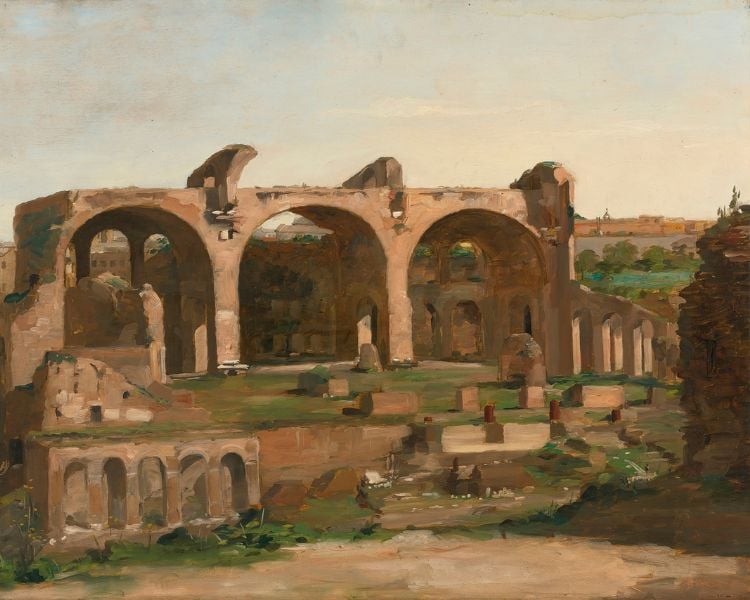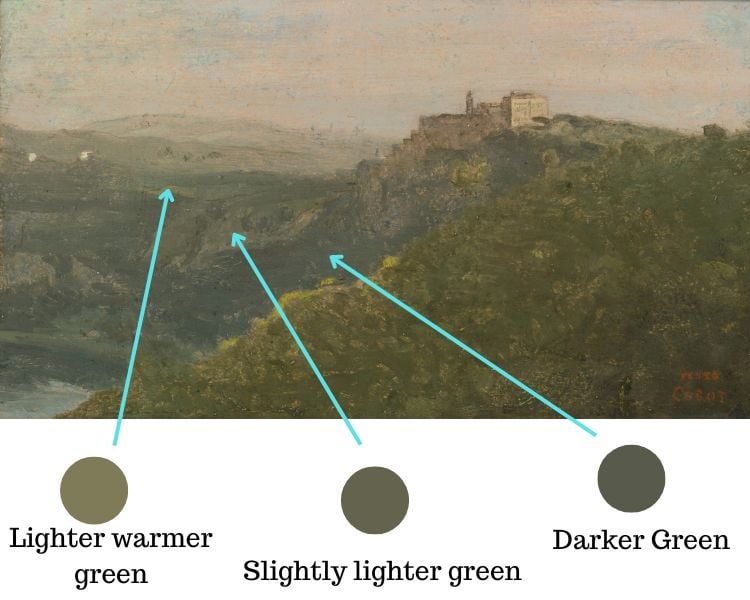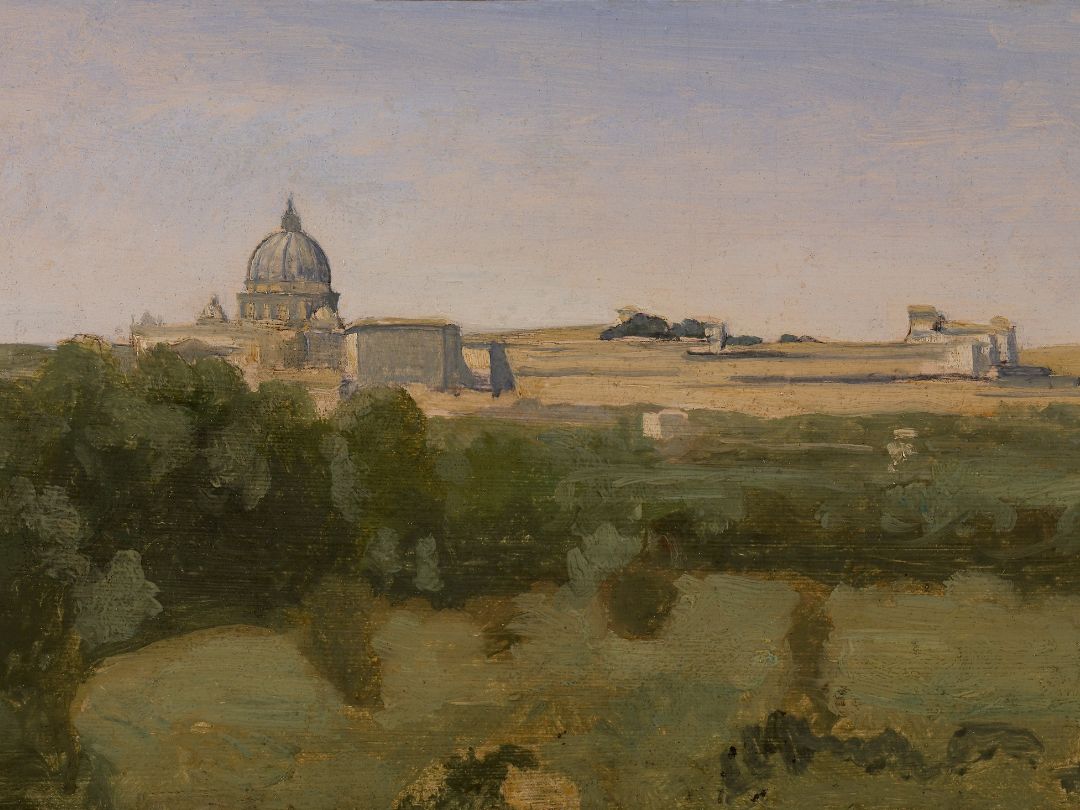As artists, it is important to draw inspiration from those who have come before us. One such painter is Jean-Baptiste-Camille Corot, a French painter known for his breathtaking depictions of landscapes both in France and Italy.
In this article, I aim to illuminate the captivating allure of his Italian landscapes. Specifically, I will delve into the elements that render them extraordinary and profoundly impactful.
Corot painting (plein air) in italy
Corot first visited Italy from 1825 to 1828 as part of a trip sponsored by the French government. It was this trip that marked a turning point in his career as an artist.
Such a trip to Italy was considered essential at the time to the formation of a landscape artist.
Corot was taken by the stunning Italian landscapes, which he later called the “mother of all arts.” He painted several sketches out of doors in the Roman countryside during this trip. In these sketches, he captured the light, atmosphere, and mood of the landscapes in a way that was truly revolutionary.

John Constable initially pioneered painting out of doors, or “en plein air”. Corot brought outdoor painting to new heights as he bridged the freshness of outdoor painting and the structure and organizing principles of classical landscape painting. This development eventually helped pave the way towards impressionism.
However, all of this would never have been possible without the groundbreaking work he did with his outdoor painting in Italy. Here we take a look at some of the important painting studies he created during his time there.
The Bridge at Narni

One of Corot’s most famous Italian landscapes done during his early years in Italy is “The Bridge at Narni”. It is an example of Corot’s absorption of neoclassical painting during his years as a student in Paris. However more importantly, it illustrates how Corot blended empirical classical principles with the spontaneity of outdoor painting.
Incorporating the past
Corot had a deep knowledge of important landscape artists of the past such as Poussin. As it was their work that influenced how he saw and painted nature to a great degree. He was able to create compositions that paid homage to the classical works of the past while entering new territory by painting from life and seeing the world with fresh eyes.

Although the Bridge at Narni is an early work by Corot, the piece has had a lasting influence on landscape painting. Its use of atmospheric perspective, subtle earthy tones and distinct brushstrokes earned it a place among Corot’s most revered works. The painting reveals how Corot translated his visual discoveries on canvas.
View of Marino in the Alban Mountains in the morning
In the work “View of Marino in the Alban Mountains in the morning” we can see how Corot responds to what he saw. Notice how the colors, light and sense of atmosphere are all painted with an enormous amount of engagement and attention to the poetic quality of his subject.

Corot’s ability to capture the moment
As Corot painted out of doors in the elements he directly experienced how all the color spots interact with one another. In this way, he didn’t just paint a landscape but the visual experience present in that particular moment in time. This level of a visual study would not have been possible if it weren’t for plein air painting. It gave him the ability to directly respond in the moment.
In addition, the painting can also serve as an illustration of how to keep a fresh perspective on the world around us. Through careful observation and study, we are able to create works that capture moments in time, reflecting both the beauty of nature and its fragility.
View of Genoa by Camille Corot
Take a moment to admire Camille Corot’s “View of Genoa”. Notice the meticulous attention to detail in all of Corot’s artworks. It’s fascinating to observe closely and truly appreciate the craftsmanship behind each painting.

Lesson from Corot to observe closely
Thus, Corot’s painting serves as a reminder to take the time to carefully observe our environment and the beauty of its rich, vibrant colors. It takes time to learn to see as an artist. By taking the time to absorb our surroundings, we can ensure that the beauty we observe today remains for future generations to enjoy and be inspired by.
Corot’s paintings have been a source of inspiration to many painters over time. Especially those who have sought to emulate him by painting outdoors and capturing the moment as it is.
View of Lake Nemi with Genzano in the distance

The painting View of Lake Nemi with Genzano in the Distance, by Jean-Baptiste Camille Corot, is a stunning example of how one can observe and capture the essence of their environment. The striking color spots are evidence of Corot’s commitment to exploring nature through visual discovery.
More than anything, the painting is a demonstration of capturing the essence of a visual moment in time. Which is a through line in many of his Italian plein air works. Corot uses simple shapes of light and dark and subtle color changes to show us the spirit of the moment. It is in particular works like these that would later inspire artists such as monet.

Corot’s influence on painting
Corot’s influence on landscape painting continues to this day. He played a key role in the emergence of the Barbizon School of painters. They focused on painting landscapes outdoors rather than in the studio. The way Corot uses color and light in his Italian landscapes is particularly influential. Many painters in the 19th and early 20th centuries looked to him as a guiding light.
Corot’s work has had an enduring legacy on landscape painting, and his influence can still be seen in many contemporary works. His contribution to the art world is impossible to deny. As the impact he had on Italian plein air painting in particular cannot be understated. He was a pioneering figure who helped shape the course of modern art. Therefore, he will be remembered as one of the greats.
Corot and the timeless principles of color and light

The Italian landscapes painted by Jean-Baptiste-Camille Corot are a testament to the beauty and power of nature. They remind us of the importance of connecting with the natural world and of the rich history of art that has come before us.
As artists, we can learn much from Corot’s use of color and light – lessons that remain relevant to this day. He created his work by having a deep understanding and appreciation of the fundamentals. Because he understood how light and color work, he was able to freely paint and blaze new trails forward.






2 thoughts on “Jean-Baptiste-Camille Corot & the Impact of His Italian Paintings”
Thank you very much for this interesting article Elisabeth, highly appreciated – best regards. Hans
You are so welcome Hans, glad you enjoyed!